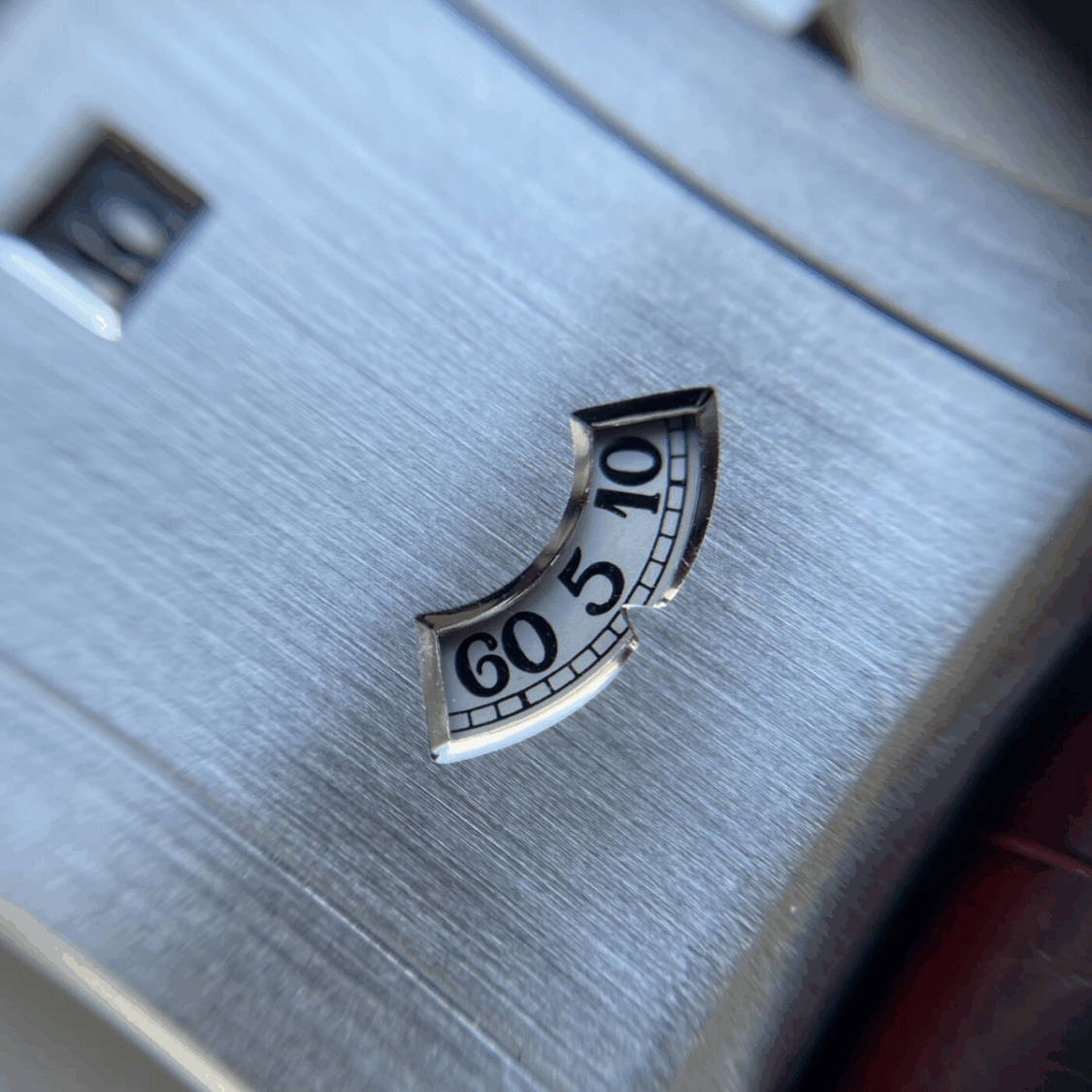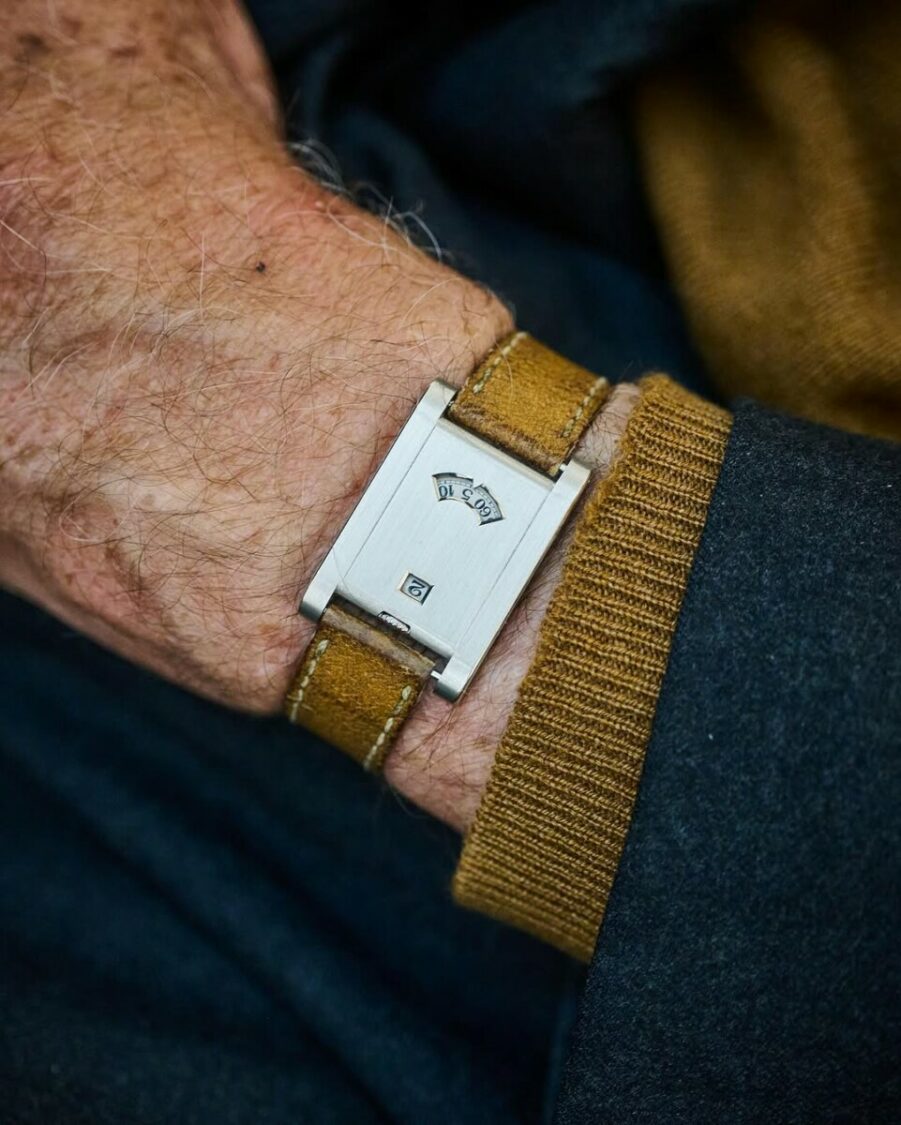
We are excited.
About this event. About the innovations. About these watches. About Cartier… But mainly about this new way of transmitting this excitement to you, our dear readers.
This article is a collaborative effort between myself, Walid, and Ms. Inass Akisra. The beloved Time-Telling Magazine writer and editor that never seizes to nail design oriented articles. So for something like the Cartier Tank à Guichets, or Cartier in general as a design driven brand/studio, we had to link up.
We had to link up for a good old “Cartier history lesson” article, from the sleek outsides to the intricate insides.

Inass here !
There are reissues, and then there are resurrections. Cartier’s 2025 revival of the Tank à Guichets falls firmly in the latter category — a design by Louis Cartier, so ahead of its time in 1928, it’s still on top of the design game nearly a century later. Originally conceived as a defiant rejection of traditional timekeeping aesthetics (hands? visible dials? overdone.), the Tank à Guichets ditched everything ornamental for a full metal face and two small windows: jumping hours, dragging minutes. It was modernism on the wrist — the horological equivalent of a steel skyscraper in a world of Edwardian mansions.

This year, Cartier brings it back under the Privé collection, and it’s as sculptural and self-assured as ever. The 2025 edition lands in platinum, rose gold, and yellow gold — each with a vertically brushed façade that makes the case itself the dial. But the real flex is in the details: a limited edition of 200 pieces features the apertures offset at 10 and 4 o’clock — a deliberate break from symmetry that feels both measured and subversive. The minute disc now drags horizontally. There’s no logo. No numerals. Just presence. More on the technicality in a minute with Walid.
In a landscape flooded with maximalist skeletonized timepieces, this watch brings us back to the basics. Pared down, precise, and quietly radical. It’s Cartier doing what it does best: power in understatement. You already know what time it is — what matters is how you wear it.
About that “You know what time it is”… one of the major “personality traits” about the Tank à Guichet is, well, how you tell the time (pun intended). And that’s the thing…
Okay, Walid here.
Let’s get one thing straight: the Cartier Tank à Guichets isn’t your average Tank. No Roman numerals, no blued steel hands, no dial even. Just two tiny windows cut into a brushed metal face—like a time machine trying to stay incognito. Behind those Guichets (that’s French for “little windows,” by the way), Cartier is hiding a very specific kind of mechanical chaos: a fully mechanical jump hour and jump minute complication.

Now pause. About visibility and legibility.
Due to its dimensions, and those of the apertures, an instant read of the time is not what one should expect with this watch. Although it’s what it’s designed for…
Christian Zeron from Theo&Harris made a comment that I couldn’t stop thinking about. He said that on the legibility spectrum, A Luminor from Panerai and the Tank à Guichets fall on opposite extremes.
While handling a vintage 2817 a few months ago in a private collectors’ dinner, one thing was on my mind. Of course aside from the wow factor of holding an art piece, I kept saying to myself “Walid you are too blind for this”.

But anyways, here’s how it works.
Instead of hands rotating around a dial, the time is displayed on two spinning discs—one for the hours, one for the minutes—that jump to their next position instantly. The hour jumps every 60 minutes. The minute disc, every five. The result is this very stealthy, very snappy digital time readout.

That sudden “click” isn’t just for drama—it’s what watchmakers call an instantaneous jump, and it takes a lot more finesse than you’d think. The whole movement has to build up tension over time, storing energy in a spring-loaded cam system, then SNAP releases it at just the right moment to throw the disc forward exactly one notch. Miss the timing or mess up the torque, and the whole illusion falls apart.

This clever complication goes way back. The first Tank à Guichets dropped in 1928, and it was one of the earliest digital wristwatches—mechanically speaking—in history. Back then, Cartier most likely used a LeCoultre ébauche as the base and modified it in-house or through their U.S. branch, the European Watch and Clock Co. These early pieces were hand-wound and charmingly temperamental.

The jump mechanisms were kind of energy hogs, meaning they drained power like a phone on 3% running Google Maps. Jumps weren’t always crisp, power reserves were short, and timing could get a little fuzzy. But even then, it was clear: this was a radical little machine hiding in a classy case.
When Cartier decided to bring it back in the 2000s under the CPCP (Collection Privée Cartier Paris) line, they gave it a movement makeover. The Caliber 9752 MC, a hand-wound movement based on the ultra-thin Piaget 450P. Cartier took this sleek little base and reworked it to handle the stress of the jumping discs—no small feat considering how much punch those jumps need and how tight the case tolerances are. It offered around 40 hours of power reserve and was finished like a show car: Geneva stripes, beveling, and a platinum case to match.

Ultra-thin, hand-wound

Then came the 2021 reboot, and Cartier didn’t just update the look—they built a new engine for it. The Caliber 9917 MC was developed in-house specifically for this model, and it’s got that lean, modern movement vibe. Manual wind, 36-hour power reserve, and a beat rate of 4 Hz (28,800 vph), which means it’s ticking fast and steady—perfect for precise jumps. It’s got skeletonized bridges, optimized energy flow, and super-clean engineering focused purely on making those discs land with pixel-perfect alignment, every single time.
And speaking of those discs—they’re not just random rotating plates. They’re made of super-light materials like aluminum or titanium, which matters a lot because heavier discs mean more torque is needed to move them, which in turn messes with the rest of the movement. By keeping them feather-light, Cartier makes sure they jump smoothly without dragging down the balance wheel. The numerals are either engraved and filled or perfectly printed, and the discs are laser-aligned during assembly to make sure they always land square in their windows. No half-jumps, no bounce, no blur. Just clean digital readout, Cartier-style.
None of this works without serious attention to energy management !!
The movement’s mainspring doesn’t just power the time—it also has to deliver bursts of energy strong enough to flip those discs without throwing off everything else. That means cams that build and store tension, intermediate wheels that act like mechanical buffers, and precisely shaped gear teeth that reduce friction and keep things moving like silk. Every five minutes, a miniature mechanical explosion happens inside this watch. And it doesn’t even break a sweat.
With no dial to hide behind, the discs and their positioning have to be flawless. There’s nowhere to tuck a misalignment or cover a mechanical hiccup. So Cartier engineered fixed guides inside the movement to keep the discs perfectly concentric. They use ultra-precise positioning during assembly, and some modern versions even include shock protection to keep your time aligned even if you knock it against a doorknob. The margin for error? Basically zéro…
So yeah, the Tank à Guichets may seem like a “chill girl” but lemme tell you she IS working hard under that brushed façade. It’s been a masterclass in minimalism waaay before it became an aesthetic.
“It is in any of its incarnations, a watch for the soigné individual”
Mr. Jack Forster – The 1916 Company
Whether you’ve caught a glimpse of it on the wrists of seasoned collectors like Mr. Auro Montanari, or immortal artists like the infamous American pianist and composer Mr. Duke Ellington; the Tank à Guichets could fairly be classified as the most emblematic Tank ever made. Some even dare to say, the best Cartier watch ever made.



Either way, you are not wrong. Because this article was only about the basic concepts that make the à Guichets what it is. However, one thing we have deliberately abstained from discussing —Or else this would become something else rather than an enjoyable story— is the large catalog of configurations and references that fall under the Tank à Guichets umbrella.

And as with significant pieces like these, rarity is often of second nature. Especially since production for these watches ceased from the 1930s, when they were a special order model, then back in 1996.
First joint article was fun. Let us know if you want more !
*We do not own the rights to any of these photos. please note that all images and copyrights belong to their original owners. no copyright infringement intended.*
SUBSCRIBE NOW AND NEVER MISS A THING !

